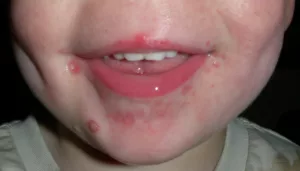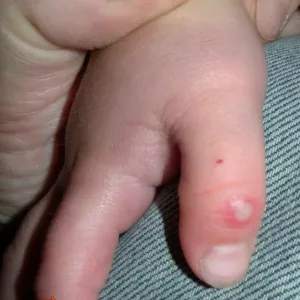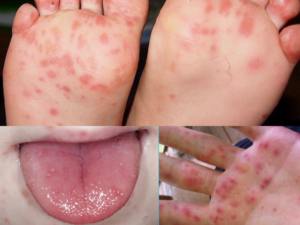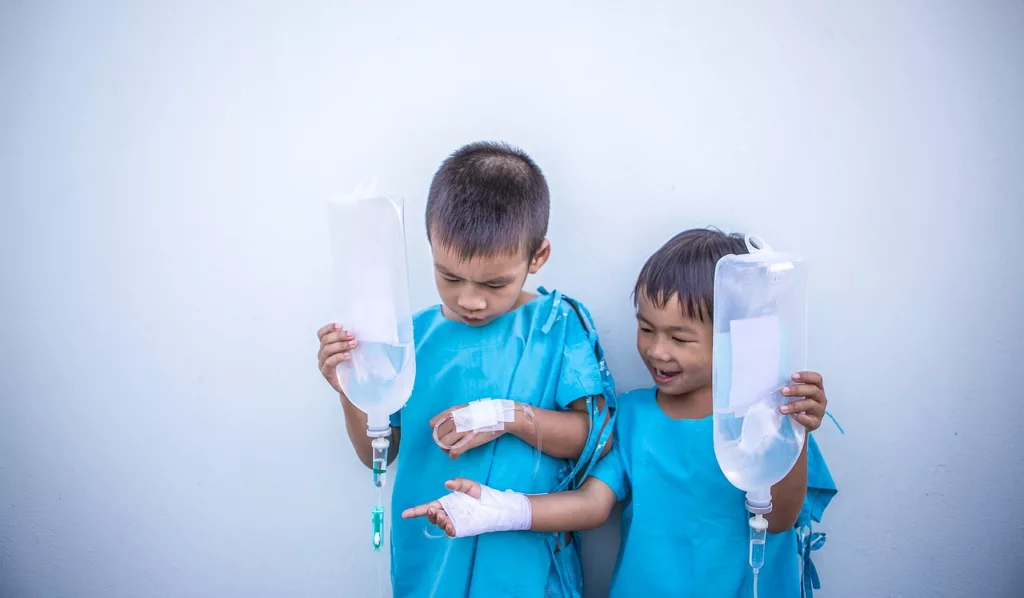HFMD : This article titled “Signs and Treatment of Hand, Foot, and Mouth Disease in Kids” is a comprehensive resource that covers a wide range of health topics specifically related to children. It offers valuable insights and information on common ailments such as anxiety, asthma, bedwetting, chickenpox, constipation, coughs and colds, and more. The article also includes essential details on hand, foot, and mouth disease, a contagious viral infection commonly affecting young children. Additionally, readers will find a symptom checker and health service finder tool to assist in identifying and seeking appropriate care. This article is an invaluable resource for parents, caregivers, and professionals alike, providing expert guidance and support for maintaining the health and well-being of children.
HFMD : Signs and Symptoms of Hand, Foot and Mouth Disease
Hand, Foot and Mouth Disease (HFMD) is a common viral illness that primarily affects infants and young children. It is characterized by a variety of symptoms that may vary in severity. Recognizing the signs and symptoms of HFMD is crucial for early detection and appropriate management.
Fever
Fever is one of the most common symptoms of Hand, Foot and Mouth Disease. It typically presents as a sudden onset of high temperature, often exceeding 101 degrees Fahrenheit (38.3 degrees Celsius). The fever may persist for several days and can be accompanied by other symptoms such as fatigue, weakness, and general discomfort.
Sore throat and mouth sores
Another hallmark symptom of HFMD is a sore throat and the development of painful mouth sores. These sores, also known as ulcers, can appear on the tongue, gums, and inside of the cheeks. They may be accompanied by difficulty swallowing, eating, or drinking. The ulcers can be small red spots or develop into larger, painful blisters.
Rash on hands, feet, and buttocks
The characteristic rash of HFMD typically appears a few days after the onset of fever and sore throat. It commonly affects the hands, feet, and buttocks but can also spread to other parts of the body. The rash presents as small, red spots or bumps that may develop into fluid-filled blisters. These blisters can be painful and may eventually burst, leaving behind scabs.
Loss of appetite
Children with Hand, Foot and Mouth Disease often experience a loss of appetite. The sore throat and mouth sores can make eating and swallowing painful, leading to a decreased desire for food. It is essential to ensure that the child stays hydrated and receives adequate nutrition during this time.
Irritability and fussiness
Children infected with HFMD may exhibit increased irritability and fussiness. The discomfort caused by the fever, sore throat, and mouth sores can make them irritable and prone to crying. They may also have difficulty sleeping, leading to disturbances in their normal routine.

HFMD : How Hand, Foot and Mouth Disease Spreads
Hand, Foot and Mouth Disease is highly contagious and can spread rapidly, especially in close quarters such as schools, daycare centers, and households. Understanding how HFMD spreads can help prevent its transmission and manage outbreaks effectively.
Viral transmission through direct contact
HFMD is primarily spread through direct contact with an infected individual. This can occur through exposure to respiratory secretions, such as saliva and nasal discharge, or by contact with fecal matter. The virus can be present on surfaces, objects, or hands and can be easily transferred from person to person through touching, sharing utensils, or close contact.
Contagious nature of the disease
Hand, Foot and Mouth Disease is highly contagious, especially during the first week of illness when the virus is most concentrated in bodily fluids. Infected individuals can transmit the virus to others even before they display symptoms. It is important to take precautions to prevent the spread of the disease, especially in settings where children are in close contact with each other.
Potential spread through respiratory droplets and fecal-oral route
In addition to direct contact, HFMD can also spread through respiratory droplets when an infected person coughs or sneezes. The virus can then be inhaled by others in close proximity. The fecal-oral route is another potential mode of transmission, especially when contaminated hands come into contact with the mouth. Taking measures to minimize exposure to respiratory droplets and practicing good hygiene can significantly reduce the spread of the disease.

HFMD : Diagnosing Hand, Foot and Mouth Disease
Early diagnosis of Hand, Foot and Mouth Disease is crucial for appropriate management and to prevent the spread of infection. Healthcare professionals utilize various methods to diagnose HFMD and differentiate it from other similar conditions.
Physical examination
A physical examination is often the first step in diagnosing Hand, Foot, and Mouth Disease. The healthcare provider will examine the child for the characteristic symptoms, including fever, sore throat, mouth sores, and rash. They may also check for swollen lymph nodes and assess the severity of symptoms.
Laboratory testing
In some cases, laboratory testing may be necessary to confirm the diagnosis of Hand, Foot and Mouth Disease. This can involve obtaining samples from the mouth, throat, or affected skin lesions to test for the presence of the virus. Laboratory tests help identify the specific virus causing the infection and rule out other conditions with similar symptoms.
Differentiating from other similar conditions
Hand, Foot and Mouth Disease shares symptoms with other viral infections, such as herpangina and chickenpox. However, there are certain characteristics that can help differentiate HFMD from these conditions. For example, the rash in HFMD is typically localized to the hands, feet, and buttocks, while chickenpox presents with a more widespread rash. Healthcare professionals rely on their clinical judgment and diagnostic tools to accurately differentiate HFMD from other similar conditions.

HFMD : Treating Hand, Foot and Mouth Disease
Currently, there is no specific cure for Hand, Foot and Mouth Disease. Treatment mainly focuses on relieving the symptoms and providing supportive care to promote recovery.
Self-care and home remedies
In most cases, Hand, Foot and Mouth Disease is a self-limiting illness and resolves on its own without medical intervention. It is essential to provide comfort and supportive care to the affected child at home. This can include ensuring they get plenty of rest, maintaining hydration, and administering over-the-counter pain relievers under medical guidance. It is important to consult a healthcare professional before giving any medications to children.
Managing fever and pain
Fever and pain associated with Hand, Foot and Mouth Disease can be managed by using non-aspirin pain relievers such as acetaminophen or ibuprofen. These medications can help reduce fever and alleviate discomfort. It is important to follow the appropriate dosage instructions and seek medical advice if the child’s symptoms worsen or persist.
Providing fluids and hydration
Maintaining adequate hydration is crucial for children with Hand, Foot and Mouth Disease. Encouraging the child to drink plenty of fluids, such as water, electrolyte solutions, and soothing beverages, can help prevent dehydration. It may be necessary to provide smaller, more frequent meals to ease discomfort while ensuring the child receives proper nutrition.
Maintaining good hygiene practices
Practicing good hygiene is essential for preventing the spread of Hand, Foot and Mouth Disease within the household and community. Encourage frequent handwashing with soap and water, especially after using the toilet, before meals, and after touching potentially contaminated surfaces. Avoid sharing utensils, cups, and towels to minimize transmission. Cleaning and disinfecting surfaces regularly can further reduce the risk of spread.

HFMD : Preventing the Spread of Hand, Foot and Mouth Disease
Minimizing the transmission of Hand, Foot and Mouth Disease is vital to prevent outbreaks and protect vulnerable individuals. Implementing preventive measures can significantly reduce the spread of the virus.
Frequent handwashing
Promoting frequent handwashing with soap and water is essential in preventing the transmission of Hand, Foot and Mouth Disease. Encourage children, caregivers, and family members to wash their hands thoroughly for at least 20 seconds, paying attention to all surfaces of the hands, including the fingers and under the nails. Hand sanitizers with at least 60% alcohol can be used when soap and water are not readily available.
Avoiding close contact with infected individuals
Minimizing close contact with infected individuals is crucial in preventing the spread of Hand, Foot and Mouth Disease. Encourage individuals who have been diagnosed with HFMD to stay home until they are no longer contagious, as advised by their healthcare provider. Avoid sharing personal items and discourage close physical contact, such as hugging and kissing, especially during the active phase of the illness.
Cleaning and disinfecting contaminated surfaces
Regular cleaning and disinfection of commonly touched surfaces can help reduce the transmission of Hand, Foot and Mouth Disease. Use appropriate disinfectants and follow the manufacturer’s instructions for effective disinfection. Pay special attention to surfaces that may come into contact with bodily fluids, such as countertops, doorknobs, toys, and bathroom fixtures.
Educating children about proper hygiene practices
Teaching children about proper hygiene practices is essential in preventing the spread of Hand, Foot and Mouth Disease. Educate them about the importance of handwashing, covering their mouth and nose when coughing or sneezing, and avoiding unnecessary contact with bodily fluids. Encourage them to inform an adult if they experience any symptoms or notice their peers exhibiting signs of illness.

HFMD : Complications Associated with Hand, Foot and Mouth Disease
Although most cases of Hand, Foot and Mouth Disease resolve without complications, there are potential risks involved, particularly in severe cases or in individuals with weakened immune systems.
Rare neurological complications
In rare instances, Hand, Foot and Mouth Disease can lead to neurological complications. These complications may include aseptic meningitis, inflammation of the brain (encephalitis), or inflammation of the spinal cord (myelitis). These conditions can cause symptoms such as severe headache, stiff neck, changes in behavior, or difficulty walking. Prompt medical attention is necessary if any of these symptoms occur.
Dehydration and electrolyte imbalance
One common complication of Hand, Foot and Mouth Disease is dehydration. The combination of fever, sore throat, and mouth sores can make it difficult for children to drink adequate fluids. Dehydration can lead to electrolyte imbalances, which can f
urther worsen symptoms and require medical intervention. Ensuring proper hydration and seeking medical advice if signs of dehydration develop is essential in managing Hand, Foot and Mouth Disease.

HFMD : When to Seek Medical Attention
While most cases of Hand, Foot and Mouth Disease can be managed at home, there are certain warning signs that warrant prompt medical attention. It is important to be vigilant and seek medical advice if any of the following symptoms or complications arise:
Persistent high fever
If the child’s fever persists for more than a few days or is accompanied by other concerning symptoms, medical attention should be sought. A healthcare professional can evaluate the child and determine the appropriate course of action.
Severe headache or stiff neck
Severe headache or stiffness in the neck can be signs of a more serious condition, such as meningitis. If the child experiences these symptoms along with Hand, Foot and Mouth Disease, immediate medical attention is necessary.
Signs of dehydration
Dehydration can occur due to decreased fluid intake or excessive fluid loss from fever, sweating, or vomiting. Signs of dehydration include a dry mouth, decreased urine output, lethargy, or sunken eyes. If these symptoms develop, medical evaluation is needed to assess the child’s hydration status and provide appropriate intervention.
Difficulty swallowing or breathing
Hand, Foot and Mouth Disease can cause swelling and discomfort in the throat, making swallowing and breathing challenging. If the child experiences severe difficulty swallowing or breathing, seek immediate medical attention to prevent any further complications.
Drowsiness or irritability
Changes in behavior, such as drowsiness or irritability, can indicate a more severe infection or complications. If the child’s behavior becomes increasingly abnormal or concerning, medical evaluation is necessary.
HFMD : Managing Hand, Foot and Mouth Disease at School or Childcare Settings
When Hand, Foot and Mouth Disease occurs in a school or childcare setting, it is important to implement measures to control the spread and ensure the safety of all children and staff members.
Encouraging exclusion of infected children
In cases of Hand, Foot and Mouth Disease, it is crucial to exclude infected children from attending school or daycare until they are no longer contagious. Strict adherence to exclusion policies helps prevent the spread of the virus within the facility. Healthcare professionals and local health authorities can provide specific guidelines on the duration of exclusion.
Enhancing hygiene measures
Schools and childcare settings should enhance their hygiene measures to minimize the risk of Hand, Foot and Mouth Disease transmission. This includes promoting regular handwashing among children and staff, providing hand sanitizers in classrooms and common areas, and implementing proper cleaning and disinfection protocols. It is important to educate staff and children on proper hand hygiene practices and respiratory etiquette.
Educating staff and parents
Raising awareness about Hand, Foot, and Mouth Disease among staff and parents is essential in controlling outbreaks. Schools and childcare centers can provide information about the signs and symptoms, prevention strategies, and when to seek medical attention. This empowers parents and caregivers to take appropriate actions and understand the importance of prompt communication with the school or daycare facility.
HFMD : Implications for Parents and Caregivers
Hand, Foot and Mouth Disease can have significant implications for parents and caregivers, requiring them to balance their work and caregiving responsibilities while ensuring the child’s recovery and comfort.
Balancing work and caregiving responsibilities
Parents and caregivers may face challenges in balancing their work commitments with providing care for a child with Hand, Foot and Mouth Disease. Communication with employers or childcare providers is crucial to make necessary arrangements, such as taking time off work or finding alternative childcare options. Flexibility and understanding from both employers and family members can help alleviate some of the stress associated with managing the illness.
Supporting the child’s recovery and comfort
Parents and caregivers play a vital role in supporting the child’s recovery and providing comfort during Hand, Foot and Mouth Disease. This can involve ensuring the child receives adequate rest, administering medications as directed, providing soothing foods and fluids, and offering emotional support. Monitoring the child’s progress and seeking medical advice when needed is essential for a smooth recovery.
Communicating with healthcare providers
Maintaining open and effective communication with healthcare providers is important in managing Hand, Foot and Mouth Disease. Regular updates on the child’s symptoms, adherence to recommended treatments, and any concerns or questions should be addressed promptly. Healthcare providers can provide guidance, reassurance, and monitor the child’s progress.
Addressing concerns of other family members
When a child is diagnosed with Hand, Foot and Mouth Disease, it is common for other family members to have concerns about their own health. Addressing their concerns and providing education about the virus can help alleviate anxiety. Emphasize the importance of good hygiene practices and encourage family members to monitor for any symptoms. If symptoms develop, they should seek medical advice.

HFMD : Hand, Foot and Mouth Disease – A Recurring Issue
Hand, Foot and Mouth Disease is known to recur, particularly in settings where young children gather, such as schools and daycare centers. Understanding the potential for repeat infections can guide preventative measures and help manage future outbreaks.
Understanding the possibility of repeat infections
Hand, Foot and Mouth Disease is caused by various strains of enteroviruses, and immunity to the specific strains may not provide long-term protection against future infections. Therefore, it is possible for individuals to experience multiple episodes of HFMD, especially in high-risk environments. Staying vigilant and implementing preventive measures can help reduce the risk of recurrent infections.
Building immunity over time
Although repeat infections can occur, individuals who have previously had Hand, Foot and Mouth Disease may develop some level of immunity to the specific strains they have been exposed to. This can provide partial protection against severe illness or complications in subsequent infections. However, it is important to note that the immunity may not be lifelong, and individuals can still be susceptible to different strains of the virus.
In conclusion, recognizing the signs and symptoms of Hand, Foot and Mouth Disease is crucial for early detection and appropriate management. Implementing preventive measures, such as practicing good hygiene, can help minimize the spread of the virus. Prompt medical attention should be sought if any concerning symptoms or complications arise. Balancing work and caregiving responsibilities, providing support to the affected child, and addressing the concerns of other family members are important aspects for parents and caregivers to consider. Understanding the possibility of repeat infections and building immunity over time can guide preventative measures and help manage future outbreaks. By staying informed and taking necessary precautions, parents, caregivers, and healthcare professionals can work together to mitigate the impact of Hand, Foot and Mouth Disease on children’s health and well-being.

